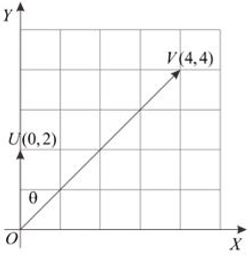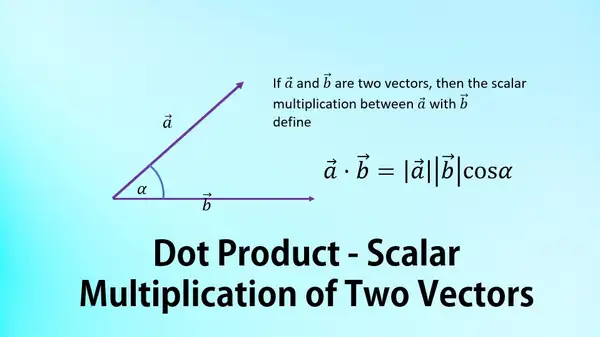Learn about the dot product, a fundamental operation in linear algebra that calculates the scalar product of two vectors. Understand its geometric interpretation, properties, and applications in various fields, including physics, computer graphics, and machine learning.
Table Of Contents
In this article we will learn about operations on vectors, namely vector multiplication or dot product or dot product. After previously we learned operations on vectors, namely addition and subtraction on vectors↝ and multiplication of vectors with scalars↝ , so this time we will continue with the discussion of Vector Dot Multiplication (Dot Product). We can present vectors in algebraic form and geometric form where two vectors will form a certain angle. So, we can calculate the angle between the two vectors by applying the concept of Vector Dot Multiplication. Before continuing to master the material vector length↝ first.
Dot vector is also called scalar multiplication between two vectors, because even though the two elements being multiplied are vectors, the product is a scalar. The symbol for multiplication is a dot (.).
Definition:
Geometrically Dot Multiplication (dot product)
Example of Geometrically Dot Vector Multiplication:
Tentukan $\vec{u}\cdot \vec{v}$ jika $\vec{u}=\left( \begin{matrix} 0\\ 2\end{matrix} \right)$ dan $\vec{v}=\left( \begin{matrix} 4\\ 4\end{matrix} \right)$! If 𝑎 ⃗ and 𝑏 ⃗ are two vectors, then the scalar multiplication between 𝑎 ⃗ and 𝑏 ⃗ defined
Solution ✍️
Based on vector dot images and definitions,
 $\vec{u}=\left( \begin{matrix} 0\\ 2\\\end{matrix} \right)$, $\vec{v}=\left( \begin{matrix} 4\\ 4\end{matrix} \right)$ dan tentu $\theta =45{}^\circ $. so
$$\begin{align*}
\vec{u}\cdot \vec{v}&=\left| \vec{u} \right|\left| \vec{v} \right|\cos \theta \to \text{Definisi}\\ \vec{u}\cdot \vec{v}&=\left| \left( \begin{matrix}0\\ 2\end{matrix} \right) \right|\left| \left( \begin{matrix} 4\\ 4\end{matrix} \right) \right|\cos 45{}^\circ\\ \vec{u}\cdot \vec{v}&=\sqrt{{{0}^{2}}+2^2}.\sqrt{4^2+4^2}.\frac{1}{2}\sqrt{2}\\ \vec{u}\cdot \vec{v}&=2.4\sqrt{2}.\frac{1}{2}\sqrt{2}\\ \vec{u}\cdot \vec{v}&=8
\end{align*}$$
$\vec{u}=\left( \begin{matrix} 0\\ 2\\\end{matrix} \right)$, $\vec{v}=\left( \begin{matrix} 4\\ 4\end{matrix} \right)$ dan tentu $\theta =45{}^\circ $. so
$$\begin{align*}
\vec{u}\cdot \vec{v}&=\left| \vec{u} \right|\left| \vec{v} \right|\cos \theta \to \text{Definisi}\\ \vec{u}\cdot \vec{v}&=\left| \left( \begin{matrix}0\\ 2\end{matrix} \right) \right|\left| \left( \begin{matrix} 4\\ 4\end{matrix} \right) \right|\cos 45{}^\circ\\ \vec{u}\cdot \vec{v}&=\sqrt{{{0}^{2}}+2^2}.\sqrt{4^2+4^2}.\frac{1}{2}\sqrt{2}\\ \vec{u}\cdot \vec{v}&=2.4\sqrt{2}.\frac{1}{2}\sqrt{2}\\ \vec{u}\cdot \vec{v}&=8
\end{align*}$$Theorem
Algebraically Dot Multiplication (dot product)
From the proposition above, it follows that multiplication directly involves the elements of the vector, namely:
- Jika $\vec{u}=\left( \begin{matrix}a_1\\\\ a_2\\\\ \end{matrix} \right)$ dan $\vec{v}=\left( \begin{matrix} b_1\\\\ b_2\\\\\end{matrix} \right)$ vector-vector at ${{R}^{2}}$ so $$\vec{u}\cdot \vec{v}=a_1b_1+a_2b_2$$
- Jika $\vec{u}=\left( \begin{matrix} a_1\\\\a_2\\\\ a_3\\\\ \end{matrix} \right)$ dan $\vec{v}=\left( \begin{matrix} b_1\\\\b_2\\\\ b_3\\\\\end{matrix} \right)$ vector-vector at ${{R}^{3}}$ so $$\vec{u}\cdot \vec{v}=a_1b_1+a_2b_2+a_3b_3$$
Notes :
- Geometrically, the direction of the two vectors is away from the angle formed.
- The dot product of two vectors produces a scalar.
Properties of Scalar Multiplication (Dot Product) of Two Vectors:
- $\vec{a} \cdot \vec{b} = \vec{b} \cdot \vec{a}$
- $\vec{a} \cdot (\vec{b}+\vec{c}) = \vec{a}\cdot\vec{b} + \vec{a}\cdot\vec{c}$
- $\vec{a}\cdot\vec{a}=|\vec{a}|^2$
- $\vec{a}\perp\vec{b}\Rightarrow\vec{a}\cdot\vec{b}=0$
Example of Vector Dot Multiplication Questions 1
Given the vectors $ \vec{a} = (-1,2,3) $ , $ \vec{b} = (2,0,-2) $ , and $ \vec{c}= (1, -3, 4 ) $. Determine the dot product of the following vectors:
- $ \vec{a}. \vec{b} $ given $ \vec{b}. \vec{c} $
- $ \vec{a}( \vec{b}- \vec{c}) $
- $ \vec{b}( \vec{a}- \vec{c}) $
- $ ( \vec{a}- \vec{b}).( \vec{b}+ \vec{c}) $
Solution ✍️
- Determine $ \vec{a}. \vec{b} $ given $ \vec{b}. \thing{c}$ $$\begin{align*} \vec{a}. \vec{b} &= (-1,2,3).(2,0,-2)\\&= -1.2 + 2.0 + 3.(-2)\\&= -2 + 0 - 6\\&= -8\\\vec{b}. \vec{c} &= (2,0,-2) . (1, -3, 4 )\\&=2.1 + 0. (-3) + -2.4\\&= 2 + 0 - 8\\&= - 6 \end{align*}$$
- Determine $ \vec{a}( \vec{b}- \vec{c}) $ $$\begin{align*} \vec{b}- \vec{c} &= (2,0,-2) - (1, -3, 4 )\\&= ( 2 - 1 , 0 - (-3) , -2 - 4 )\\&= (1 , 3, -6 )\\\vec{a}( \vec{b}- \vec{c}) &= (-1,2,3) . (1 , 3, -6 )\\&= -1.1 + 2. 3 + 3. (-6)\\&= -1 + 6 - 18\\&= -13 \end{align*}$$
- Determine $ \vec{b}( \vec{a}- \vec{c}) $ $$\begin{align*} \vec{a}- \vec{c} &= (-1,2,3) - (1, -3, 4 )\\&= ( -2, 5, -1 )\\ \ vec{b}( \vec{a}- \vec{c}) &= (2,0,-2).( -2, 5, -1 )\\ &= 2.(-2) + 0.5 + -2. (-1) \\ &= -4 + 0 + 2 \\&= -2 \end{align*}$$
- Determine $ ( \vec{a}- \vec{b}).( \vec{b}+ \vec{c}) $ $$\begin{align*} \vec{a}-\vec{b} &= (-1,2,3) - (2,0,-2)\\&= ( -3, 2, 5 ) \\\vec {b}+ \vec{c} &= (2,0,-2) + (1, -3, 4 )\\&= (3, -3, 2)\\( \vec{ a}- \vec{b}).( \vec{b}+ \vec{c}) &= ( -3, 2, 5 ) . (3, -3, 2)\\&= -9 + -6 + 10\\&= -5 \end{align*}$$
Example of Vector Dot Multiplication Questions 2
If $ \vec{p} $ and $ \vec{q} $ form an angle $ 60^\circ $, with $ |\vec{p}| = 6 $ , $ |\vec{q}| = 5 $ , then determine the value $ \vec{p}.\vec{q} $!
Solution ✍️
$$\begin{align*} \vec{p}.\vec{q} &= |\vec{p}||\vec{q} | \cos \theta \\&= 6 . 5. \cos 60^\circ\\&= 30. \frac{1}{2}\\&= 15 \end{align*}$$Example of a vector dot multiplication question with the condition that there is a vector that is perpendicular
Given the vector $\vec{a} = \begin{pmatrix} k\\ 2\\ 2 \end{pmatrix},\vec{b} = \begin{pmatrix}2\\-5\\3\end{pmatrix}$ and $\vec{c}= \begin{pmatrix}2\\1\\-1\end{pmatrix}$. If vector $\vec{a}$ is perpendicular to vector $\vec{b}$, then find the value of $2\vec{a}\cdot (\vec{b}-3\vec{c})$
Solution ✍️
$$\begin{align*} \vec{a}\perp\vec{b}&\Rightarrow &\vec{a}\cdot\vec{b}&=0\\&\Leftrightarrow&\begin{pmatrix}k\\2\\2\end{pmatrix}\cdot\begin{pmatrix}2\\-5\\3\end{pmatrix}&=0\\&\Leftrightarrow&2k-10+6&=0\\&\Leftrightarrow&2k+4&=0\\ &\Leftrightarrow&2k&=4\\&\Leftrightarrow&k&=2 \end{align*}$$ Thus obtained: $\vec{a}=\begin{pmatrix}2\\2\\2\end{pmatrix}$By using the dot product property of two vectors, we obtain: $$\vec{a}\perp\vec{b}=0\\\begin{align*} \vec{a}\cdot\vec{c}&=\begin{pmatrix}2\\2\\2\end{pmatrix}\cdot\begin{pmatrix}2\\1\\-1\end{pmatrix}\\&=(2\cdot2)+(2\cdot1)+(2\cdot{-1})\\&=4+2-2=4\end{align*}\\\begin{align*}2\vec{a}\cdot(\vec{b}-3\vec{c})&=2\vec{a}\cdot\vec{b}-2\vec{a}\cdot3\vec{c}\\&=2(\vec{a}\cdot\vec{b})-6(\vec{a}\cdot\vec{c})\\&=2(0)-6(4)=-24\end{align*}$$ Jadi nilai $2\vec{a}\cdot(\vec{b}-3\vec{c})=-24$
Example of a Straight Vector Dot Multiplication Problem
Given the vectors $ \vec{p} = ( m, 2, 6 ) $ , $ \vec{q} = (-1,n,0) $ and $ \vec{r} = (6k,3,7 ) $. If $ \vec{p} \bot \vec{q} $ and $ \vec{q} \bot \vec{r} $ , then determine the value of $ 16\left( \frac{n^2 + k^2} {m^2} \right) + 2012 $ !
Note: the symbol $ \bot $ means perpendicular.
Solution ✍️
- Determine the relationship $ m , n , $ and $ k $ :
- $ \vec{p} $ tegak lurus $ \vec{q} $ $$ \vec{p}.\vec{q} = 0 \rightarrow -m + 2n + 0 = 0 \rightarrow m = 2n ….(1)$$
- $ \vec{q} $ tegak lurus $ \vec{r} $ $$ \vec{q}.\vec{r} = 0 \rightarrow -6k + 3n + 0 = 0 \rightarrow k = \frac{n}{2} ….(2)$$
- Determine the final result with press(1) and press(2): $$\begin{align*} 16\left( \frac{n^2 + k^2}{m^2} \right) + 2012 &= 16\left( \frac{n^2 + (\frac{n}{2})^2}{(2n)^2} \right) + 2012\\&= 16\left( \frac{n^2 + \frac{n^2}{4} }{4n^2} \right) + 2012\\&= 16\left( \frac{n^2 + \frac{n^2}{4} }{4n^2} \times \frac{4}{4} \right) + 2012\\&= 16\left( \frac{4n^2 + n^2}{16n^2} \right) + 2012\\&= 16\left( \frac{5n^2}{16n^2} \right) + 2012\\&= 16\left( \frac{5 }{16 } \right) + 2012\\&= 5 + 2012 = 2017 \end{align*}$$ So, the value $ 16\left( \frac{n^2 + k^2}{m^2} \right) + 2012 = 2017 $.
Angle Between 2 Vectors
From the definition and proposition above, we can find the angle between two vectors.
Example:
Determine the magnitude of the angle formed by the vector $\vec{u}=\left( \begin{matrix}6\\ 2 \end{matrix} \right)$ and $\vec{v} = \begin{pmatrix}3\\4 \end{pmatrix} $!
Solution ✍️
$$\begin{align*} & \vec{u}=\left( \begin{matrix}6\\2\end{matrix} \right)\to u_1=6,u_2=2\\ & \vec{v}=\left( \begin{matrix}3\\4\end{matrix} \right)\to v_1=6,v_2=2 \end{align*}$$ $$\begin{align*}& \cos \theta =\frac{\vec{u}\cdot \vec{v}}{\left| \vec{u} \right|\left| \vec{v} \right|}\\ & \cos \theta =\frac{u_1v_1+u_2v_2}{\left| \vec{u} \right|\left| \vec{v} \right|}\\ & \cos \theta =\frac{6.3+2.4}{\sqrt{6^2+2^2}.\sqrt{3^2+4^2}}\\ & \cos \theta =\frac{26}{\sqrt{40}.\sqrt{15}}\\ & \cos \theta =\frac{26}{10\sqrt{10}}\approx \frac{26}{31,62}\approx 0,822\\ & \theta \approx \arccos (0,822)\\ & \theta \approx 34,71 \end{align*}$$ So, the angle formed by the vector $\vec{u}$ and $\vec{v}$ is $37,41^\circ $